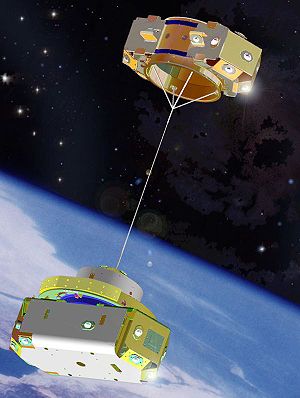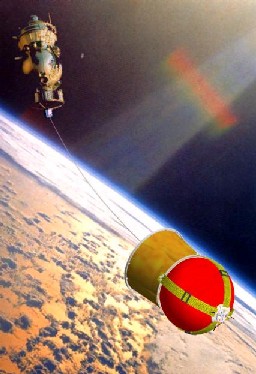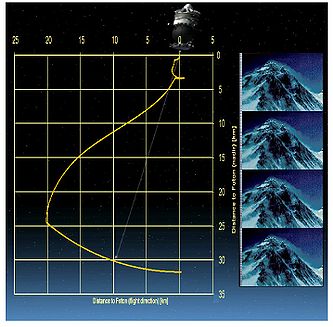
Space tether missions
Encyclopedia

Space tether
Space tethers are cables, usually long and very strong, which can be used for propulsion, stabilization, or maintaining the formation of space systems by determining the trajectory of spacecraft and payloads...
s have been deployed in space missions.
Tether satellites can be used for various purposes including research into tether propulsion, tidal stabilisation and orbital plasma dynamics.
The missions have met with a varying degrees of success, a few have been highly successful.
Description
Tethered satellites are broken up into three parts. There is the base-satellite, tether, and sub-satellite. The base-satellite contains the sub-satellite and tether until deployment. Sometimes the base-satellite is another basic satellite, other times it could be a shuttle, space station, or moon. The tether is what keeps the two satellites connected. The sub-satellite is released from the base assisted by a spring ejection system, centrifugal force or gravity gradient effects.Tethers can be deployed for a range of applications, including electrodynamic propulsion, momentum exchange, artificial gravity, deployment of sensors or antennas etc. Tether deployment may be followed by a station-keeping phase (in particular if the target state is a vertical system orientation), and, sometimes, if the deployment system allows, a retraction.
The station-keeping phase and retraction phase need active control for stability, especially when atmospheric effects are taken into account. When there are no simplifying assumptions, the dynamics become overly difficult because they are then governed by a set of ordinary and partial nonlinear, non-autonomous and coupled differential equation
Differential equation
A differential equation is a mathematical equation for an unknown function of one or several variables that relates the values of the function itself and its derivatives of various orders...
s. These conditions create a list of problems to consider:
- Three-dimensional rigid body dynamics (librational motion) of the station and subsatellite
- Swinging in-plane and out-of-plane motions of the tether of finite mass
- Offset of the tether attachment point from the base-satellite center of mass as well as controlled variations of the offset
- Transverse vibrations of the tether
- External forceForceIn physics, a force is any influence that causes an object to undergo a change in speed, a change in direction, or a change in shape. In other words, a force is that which can cause an object with mass to change its velocity , i.e., to accelerate, or which can cause a flexible object to deform...
s

Gemini 11
In 1966, Gemini 11 deployed a 30m (100 foot) tether which was stabilized by a rotation which gave 0.00015 g.TSS-1 mission
Tethered Satellite System-1 (TSS-1) was proposed by NASA and the Italian Space Agency (ASI) in the early 1970’s by Mario Grossi, of the Smithsonian Astrophysical Observatory, and Giuseppe Colombo, of Padua University. It was a joint NASA-Italian Space AgencyItalian Space Agency
The Italian Space Agency is a government agency established in 1988 to fund, regulate and coordinate space exploration activities in Italy...
project, was flown during STS-46
STS-46
STS-46 was a NASA space shuttle mission using orbiter Atlantis and launched on 31 July 1992 at 9:56:48 am EDT.-Crew:-Mission parameters:*Mass:**Orbiter landing with payload: **Payload: *Perigee: *Apogee:...
aboard the Space Shuttle Atlantis
Space Shuttle Atlantis
The Space Shuttle Atlantis is a retired Space Shuttle orbiter in the Space Shuttle fleet belonging to the National Aeronautics and Space Administration , the spaceflight and space exploration agency of the United States...
from July 31 to August 8, 1992.
The purpose of the TSS-1 mission was to verify the tether concept of gravity gradient stabilization, as well as to provide a research facility for investigating space physics and plasma electrodynamics. This mission discovered a lot about the dynamics of the tethered system, although the satellite was deployed only 260 meters (853 ft) of the 20 km proposed amount due to mechanical problems. A protruding bolt due to a late-stage modification of the deployment reel system, jammed the deployment mechanism and prevented deployment to full extension. Despite this issue, the results conclusively proved that the basic concept of long gravity-gradient stabilized tethers was sound. It also settled several short deployment dynamics issues, reduced safety concerns, and clearly demonstrated the feasibility of deploying the satellite to long distances.
The voltage and current reached using a shorter tether were too low for most of the experiments to be run. However, low-voltage measurements were made, along with recording the variations of tether-induced forces and currents. New information was learned about on the electrons that carry the "return-tether" current. The mission was reflown in 1996 as TSS-1R.
TSS-1R mission
Four years later, as a follow-up mission to TSS-1, the TSS-1R satellite was released in February 1996 from the Space Shuttle on the STS-75STS-75
STS-75 was a United States Space Shuttle mission, the 19th mission of the Columbia orbiter.-Crew:-Mission parameters:*Mass: payload*Perigee: *Apogee: *Inclination: 28.5°*Period: 90.5 min-Mission objective:...
mission. The TSS-1R mission objective was to deploy the tether 20.7 km above the space station and remain there collecting data. Scientific objectives for the TSS-1R mission were to conduct exploratory experiments in space plasma physics. Projections indicated that the motion of the long conducting tether through the Earth’s magnetic field would produce a motional EMF that would drive a current through the tether system.
TSS-1R was deployed to 19.7 km, but this was still long enough to verify numerous scientific speculations. These findings included the measurements of the motional EMF, the satellite potential, the orbiter potential, the current in the tether, the changing resistance in the tether, the charged particle distributions around a highly charged spherical satellite, and the ambient electric field. In addition, a particularly significant finding used in this thesis concerns the current collection at different potentials on a spherical endmass. Measured currents on the tether far exceeded predictions of previous numerical models by up to a factor of three. A more descriptive explanation of these results can be found in Thompson, et al..
Other scientific advancements have resulted from this mission. Improvements have been made in modeling the electron charging of the shuttle and how it effects current collection. In addition, much was learned concerning the interaction of bodies with surrounding plasma, as well as the production of electrical power. For further discussion and analysis of this mission see the referenced documents.
SEDS I and II
In 1993 and 1994, NASA launched two "Small Expendable Deployer System" experiments (SEDS-I and SEDS-II), which deployed 20 km tethers attached to a spent Delta second stage. The first fully successful orbital flight test of a long tether system was SEDS-1, which tested the simple deploy-only Small Expendable Deployer System. The tether swung to the vertical and was cut 1 orbit after the start of deployment. This slung the payload and tether from Guam onto a reentry trajectory off the coast of Mexico.The reentry was accurate enough that a pre-positioned observer was able to videotape the payload re-entry and burnup.SEDS-2 was launched on a Delta (along with a GPS Block 2 satellite) on March 9, 1994. A feedback braking limited the swing after deployment to 4°. The payload returned data for 8 hours until its battery died; during this time tether torques spun it up to 4 rpm. The tether suffered a cut 3.7 days after deployment. The payload reentered (as expected) within hours, but the 7.2 km length at the Delta end survived with no further cuts until re-entry on May 7, 1994. The tether was an easy naked eye object when lit by the sun and viewed against a dark sky.
A follow-on experiment using the SEDS deployer, PMG (Plasma Motor Generator), deployed a 500 m tether to demonstrate electrodynamic tether operation.
In these experiments, not only were tether models verified, the tests successfully showed that a reentry vehicle can be downwardly deployed into a reentry orbit using tethers.
TiPS
The Tether Physics and Survivability Experiment (TiPS) was the last tethered satellite system in orbit (other than the MAST and YES experimental satellites). It was launched in 1996 as a project of the US Naval Research Laboratory. The tether was four kilometers long. The two tethered objects were called "Ralph" and "Norton". TiPS was visible from the ground with large binoculars or a telescope and was occasionally accidentally spotted by amateur astronomers. The tether broke in July 2006. This long-term statistical data point is in line with debris models published by J. Carroll after the SEDS-2 mission, and ground tests by D. Sabath from TU Muenchen. Predictions of a maximum of two years survivability for TiPS based on some other ground tests have shown to be overly pessimistic (e.g. McBride/Taylor, Penson). The early cut of the SEDS-2 therewith must be considered an anomaly possibly related to the impact of upper stage debris.CHARGE 2
The Cooperative High Altitude Rocket Gun Experiment (CHARGE) 2 was jointly developed by Japan and NASA, to observe the current collection along with many other phenomena. The major objective was to measure the payload charging and return currents during periods of electron emission. Secondary objectives were related to plasma processes associated with direct current and pulsed firings of a low-power electron beam source. On December 14, 1985, the CHARGE mission was launched at White Sands Missile Range, New Mexico. The results indicated that it is, in fact, possible to enhance the electron current collection capability of positively charged vehicles by means of deliberate neutral gas releases into an undisturbed space plasma.In addition, it was observed that the release of neutral gas or argon gas into the undisturbed plasma region surrounding a positively biased platform has been found to cause enhancements to electron current collection. This was due to the fact that a fraction of the gas was ionized, which increased the local plasma density, and therefore the level of return current.
PMG
The objectives of the Plasma Motor Generator (PMG) mission were to test the ability of a Hollow Cathode Assembly (HCA) to provide a low impedance bipolar electrical current between a spacecraft and the ionosphere. In addition, other expectations were to show that the mission configuration could function as an orbit-boosting motor as well as a generator, by converting orbital energy into electricity. The mission was launched on June 26, 1993, as the secondary payload on a Delta II rocket [18].The total experiment lasted approximately seven hours. In that time, the results demonstrated that current is fully reversible, and therefore was capable of operating in power generator and orbit boosting modes. The hollow cathode was able to provide a low power way of connecting the electrons to and from the ambient plasma. This means that the HC demonstrated its electron collection and emission capabilities.
ProSEDS
The use of a bare section of a space-borne electrodynamic tether for an electron-collection device has been suggested as a promising alternative to end-body electron collectors for certain applications, provided that electrons are collected in a quasi-orbital-motion-limited (OML) regime (the OML regime is discussed further down this page). For a given V - Vp, plasma probe theory predicts that the collected electron current per unit area (not total current) is maximized in the orbital-motion-limited regime, which is only valid with sufficiently thin wires (explained in Section 2.1.1). NASA’s Propulsive Small Expendable Deployer System (ProSEDS) would deploy 5-km of tether to collect up to 1 – 2 A of current from the ionosphere. The current interacting with the Earth’s magnetic field would produce an electrodynamic drag thrust and reduce the de-orbit time by more than 5-km / day compared to the atmospheric drag.The bare tether concept was to be tested first during this ProSEDS mission. While the mission was canceled after NASA’s space shuttle Columbia accident, the concept could potentially be undertaken in the future. Present bare tether designs, such as the one developed for the ProSEDS mission, use a small, closely packed cross-section of wires or even a single wire as the anode. In future designs, concerns for survivability to collisions with micro-meteoroids and space debris will need to be considered. This will require the use of distributed or sparse tether cross-section geometries, which could span tens of Debye lengths depending on plasma density and temperature. One such technology that has been developed is the Hoytether. For further discussion and analysis see the following referenced documents.
JAXA initiatives
A "Foldaway Flat Tether Deployment System" has been demonstrated on an S520 sounding rocket in August 2010, a mission sponsored by the Japanese Aerospace Exploration Agency (ISAS/JAXA). This educational experiment featured the first bare tape tether deployment (i.e. without insulation, the tether itself acts as anode and collects electrons). 130 m of the total of 300 m of tether was deployed fire-hose style, purely driven by inertia and limited by friction, following a powerful, spring-initiated ejection. Accurate differential GPS data of the deployment has been recorded, and several videos have also been taken from the endmasses.Young Engineers' Satellite
 |
 |
In 1997, the European Space Agency
European Space Agency
The European Space Agency , established in 1975, is an intergovernmental organisation dedicated to the exploration of space, currently with 18 member states...
launched the Young Engineers' Satellite (YES) of about 200 kg into GTO
Geostationary transfer orbit
A geosynchronous transfer orbit or geostationary transfer orbit is a Hohmann transfer orbit used to reach geosynchronous or geostationary orbit....
with a 35 km double-strand tether, and planned to deorbit a probe at near-interplanetary speed by swinging deployment of the tether system. The orbit as achieved was not as initially planned during the design of the tether experiment and, for safety considerations, the tether was not deployed. The YES was switched on however to perform a number of secondary technology demonstration experiments. 10 Years later, the successor of YES, the YES2, deployed its 32 km tether and deorbited a small capsule, Fotino. It has been calculated that Fotino was inserted into a trajectory towards a landing site in Kazakhstan, but no signal was received. No recovery of the capsule or its remains has been attempted.
YES2
The YES2 satellite was launched September 14, 2007 from Baikonur. The Young Engineers' Satellite 2 (YES2) was a 36 kg student-built tether satellite part of ESA's Foton-M3 microgravity mission. The YES2 satellite employed a 30 km long tether to deorbit a small re-entry capsule.STARS
The STARS mission, developed by the Kagawa Satellite Development Project at Kagawa UniversityKagawa University
is a national university in Takamatsu, Kagawa, Japan. The university was established in 1949 as a national university after the consolidation and reorganization of the Kagawa Normal School, the Kagawa Normal School for Youth and the Takamatsu College of Economics .- Faculties :Faculty of...
, was launched 23 January 2009 as a secondary payload aboard H-IIA
H-IIA
H-IIA is an active expendable launch system operated by Mitsubishi Heavy Industries for the Japan Aerospace Exploration Agency . The liquid-fueled H-IIA rockets have been used to launch satellites into geostationary orbit, to launch a lunar orbiting spacecraft, and to launch an interplanetary...
flight 15, which also launched GOSAT
Greenhouse Gases Observing Satellite
The Greenhouse Gases Observing Satellite or GOSAT, also known as , is an Earth observation satellite and the world's first satellite dedicated to greenhouse-gas-monitoring, which will be used to measure densities of carbon dioxide and methane from 56,000 locations on the Earth's atmosphere...
.
Application into Future Missions and Beyond
There have already been EDT missions proposed to the moon, Mars, and even Jupiter [12, 15, 17, 165-167] The advanced tether analysis and optimizations can now be implemented from the work in this thesis. Updated enhanced results for the missions previously proposed can be obtained.State-of-the-art electron emitter technologies and electron collection theories have been presented and integrated into this work; however, there are still more possibilities on the horizon. As more innovative devices emerge, the EDT capabilities will continue to advance. Perhaps EDT technology will become more thoroughly established so that many future missions can employ this versatile technology.

